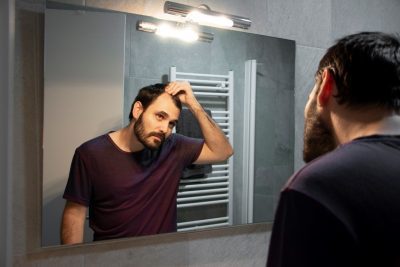While some men lose more hair than others, even so-called minor hair loss is enough to make us worry, stress, and stare in the mirror a little longer each morning. Sure, the majority of hair loss is hereditary, but what about the countless other causes we hear about? And how do we know which are based on fact and which are absolute fiction…or somewhere in between?
enough to make us worry, stress, and stare in the mirror a little longer each morning. Sure, the majority of hair loss is hereditary, but what about the countless other causes we hear about? And how do we know which are based on fact and which are absolute fiction…or somewhere in between?
Read on as we dive into five supposed causes of male pattern baldness that turn out to be more fiction than fact.
Your Hair Loss is Your Mom’s Father’s Fault
Rumor has it that if you want to know your chances of hair loss, simply look at your maternal grandfather. If he has a great head of hair, you’re in the clear. If he’s bald, you will likely be as well.
The truth is, it is now known that genetic hair loss is a complex trait that may have contributing factors from both sides of the family. And because gene expression is related to a number of other factors (hormone levels, age, stress, etc.) simply inheriting the genes for baldness does not mean that you will be bald.
Bald Men Have More Testosterone
Long standing legend says that bald men are more virile and have elevated levels of testosterone.
This isn’t necessarily the case. Men with male pattern baldness may actually have lower levels of testosterone but higher levels of the enzyme that converts that testosterone to DHT (Dihydrotestosterone), which is found in skin, hair follicles, and the prostate. The hair follicles’ sensitivity to DHT is what can cause hair loss.
Sun Exposure Speeds Up Hair Loss
Some believe that days spent lying out in the sun speeds up hair loss. While UV radiation isn’t exactly great for your skin and overall health, it’s not directly responsible for making you bald.
Hair follicle function continues even when you’re basking in the sun. The relationship between sun exposure and hair loss comes from the fact that the sun’s rays can degrade the hair shaft itself, making hair more dry, damaged, and brittle if not cared for properly. And damaged hair is more susceptible to shedding.
Wearing a Hat Suffocates Your Hair
Which came first – the bald spot or the hat? Popular belief says that frequent wearing of hats suffocates hair and speeds up the rate at which it disappears.
If you wear a really tight hat 24/7, that can put pressure on areas where the hat makes contact with your head, and this could possibly lead to traction alopecia (hair loss that’s triggered by hair being pulled too tightly on a regular basis). But if your hat isn’t overly tight nor tugging on your hair, this isn’t something to worry about.
Stress Makes Your Hair Fall Out
This one is a bit more complicated. While certain traumatic life events, like illness, substantial weight loss or gain, or losing a loved one, have been linked to hair loss, the types of hair loss associated with high levels of stress are often temporary, unlike male pattern baldness. Try to find ways to manage everyday stress, but don’t worry – it won’t lead to baldness.
Are you seeing signs of hair thinning or balding? The sooner you seek help the better. Contact the experts at DiStefano Hair Restoration Center today and start your journey to thicker, fuller hair. Call us today to schedule your free consultation.


